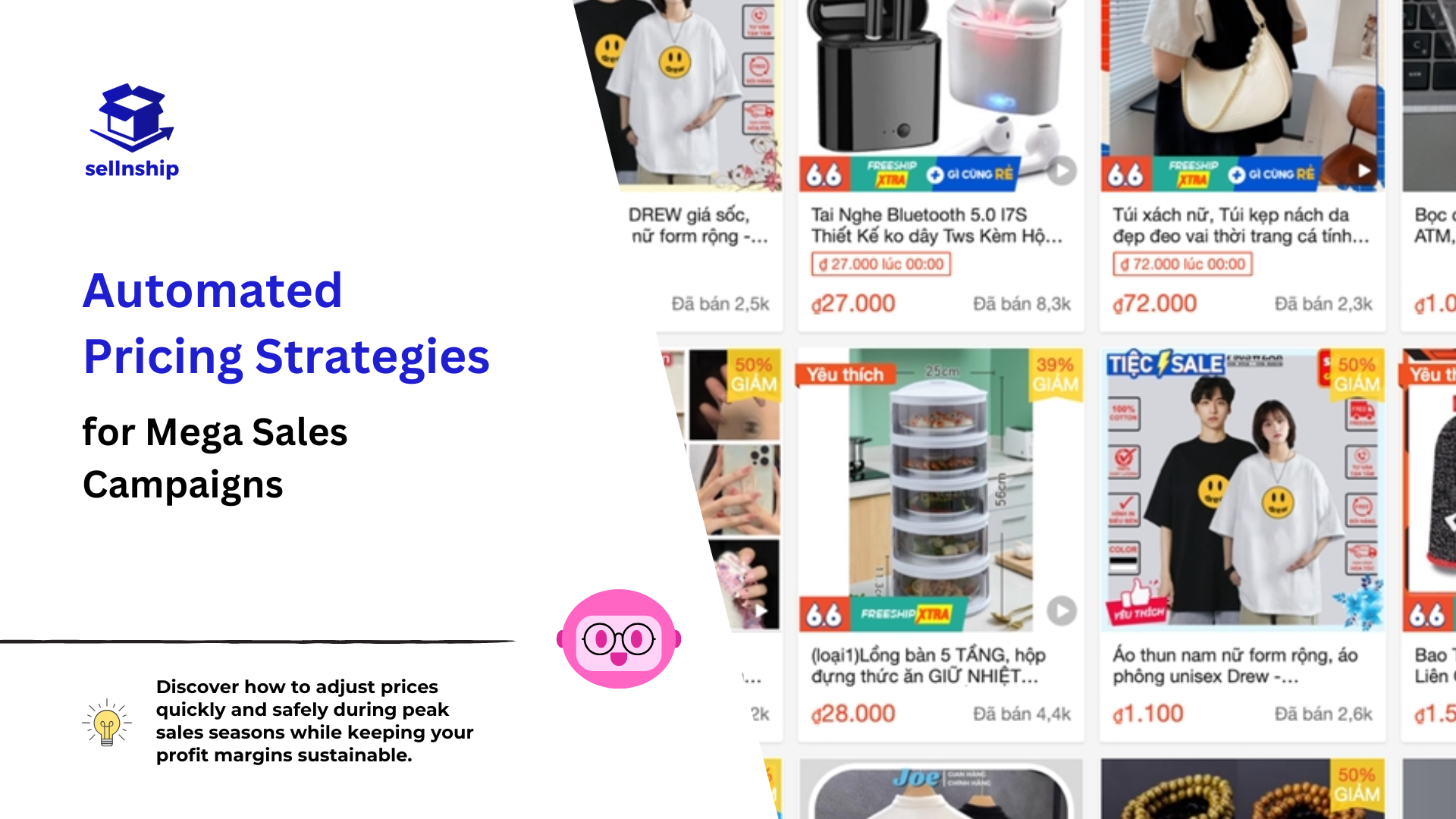Automated Pricing Strategies for Mega Sales Campaigns

During major shopping seasons (especially double-date sales like 5.5, 6.6, 7.7), price optimization has become a top priority for every seller on e-commerce platforms. In this article, SellnShip will walk you through how to adjust prices effectively – both manually and automatically – to stay profitable while riding the traffic wave during peak sales days.
The Rise of Automated Pricing in E-commerce
When product listings, traffic, and order volumes spike during major campaigns, keeping up with pricing changes manually becomes nearly impossible. Many sellers are now leveraging automated pricing systems that adjust prices based on live signals like traffic spikes, search trends, and competitor activity.
Platforms like SellnShip have integrated AI-powered pricing engines to adjust selling prices within defined limits, ensuring competitiveness while protecting expected margins. This helps eliminate human error and saves time across the operation process.
When Should You Trigger Auto-Pricing Adjustments?
- Sudden traffic spikes (outside of sales campaigns): When a product gets unusually high traffic (e.g., viral trends, being featured), enable automatic price increases to boost profit margins instead of sticking to the old price.
- Low stock levels: When inventory drops below a safe threshold (e.g., under 20%), you can set automatic price increases to control sell-out speed and avoid out-of-stock situations.
- Short-term flash campaigns: For internal promotions lasting 2–4 hours, enable AI to adjust pricing based on real-time conversion rates instead of relying on fixed discounts.
💡 Quick tip: Use SellnShip’s dashboard to pre-set triggers that auto-adjust prices based on traffic or stock thresholds. That way, you never miss a sales opportunity!
That said, automation isn't always the best answer. For specific scenarios like sudden flash sales, urgent promotions, or head-to-head competition, manual price adjustments are still necessary to stay sharp and accurate.
When Manual Pricing Still Matters
Automation is powerful, but it doesn't replace human strategy in all situations. There are cases where sellers should take full control and adjust prices manually to ensure better outcomes.
- Strategic products: For items that generate 40% or more of your total revenue, manual price control is key to protect margins in highly competitive categories.
- Peak-hour traffic: During golden time slots like 12am–2am or 8pm–10pm on sale days, price competition happens fast. AI might lag, so a human touch is safer.
- Flash sales & platform campaigns: Some events require minimum price settings to meet platform conditions. Sellers need to adjust prices manually to stay compliant and boost visibility.
Manual vs. Automated Pricing: What Works Better?
Both methods offer different strengths. Based on your operations and product portfolio, you can choose one — or combine both for best results.
| Criteria | Manual Pricing | Automated Pricing (AI) |
|---|---|---|
| Reaction speed | Fast if monitored closely | Slight delay depending on algorithm |
| Scale of application | Best for strategic items | Handles large product catalogs well |
| Customization | High – flexible control | Requires preset scenarios |
| Operational risk | Prone to human error | More stable and consistent |
| Manpower requirement | High – needs constant monitoring | Low – reduces manual tasks |
| Operating cost | High with large teams | Optimized for long-term cost |
30-Minute Checklist to Optimize Pricing During Sales
To stay in control of pricing during mega campaigns, here’s a simple but effective checklist every seller should go through:
1. Identify your top 20% revenue-driving products – these should be the focus of your pricing strategy.
2. Group products by pricing strategy: Keep price stable, light discount, or deep discount.
3. Apply the cost-based formula: Include ad cost + platform fee + minimum margin to set a safe base price before discounting.
4. Use automation tools (CSV upload) for bulk updates, and do manual tweaks for key products.
5. Monitor in real time during the first 15–30 minutes post-price update to fine-tune quickly.
💡 Pro Tip: For large-scale operations, prepare pricing templates in advance for "best", "average", and "worst" case scenarios. It will help your team respond faster.
Common Pricing Mistakes During Mega Sales
Even experienced sellers can fall into these traps during high-pressure sale periods:
- Setting prices too low: This can make buyers doubt your product quality and reduce conversion long-term.
- Ignoring hidden costs: Forgetting to account for ads, platform fees, and logistics might kill your margins.
- Set it and forget it: Adjusting prices once and not monitoring for 6–8 hours could cause missed sales or margin loss.
📅 Reminder: Whether you're using manual or auto-pricing, set up price alerts every 4–6 hours to stay updated with the market and act fast.
Final Thoughts
Combining automated pricing from platforms like SellnShip with smart manual strategies from your operations team is the ultimate way to boost revenue and control costs during peak sales.
If you're preparing for upcoming 6.6 or 7.7 campaigns, take the time to audit your pricing tools, review your product list, and make sure your dashboard is ready to go. Small steps now can lead to big wins later.